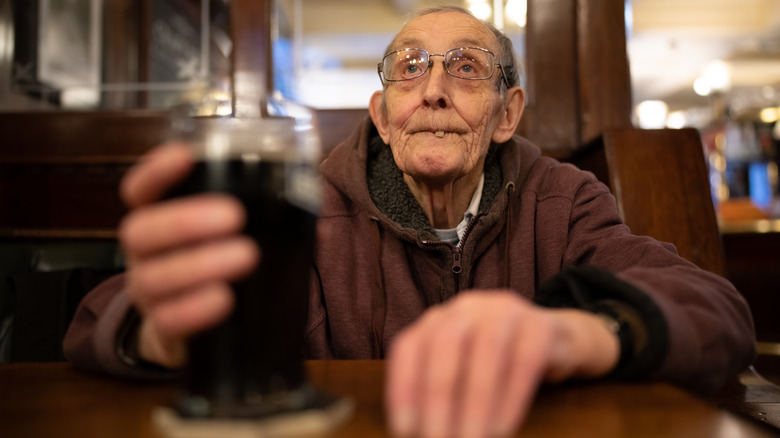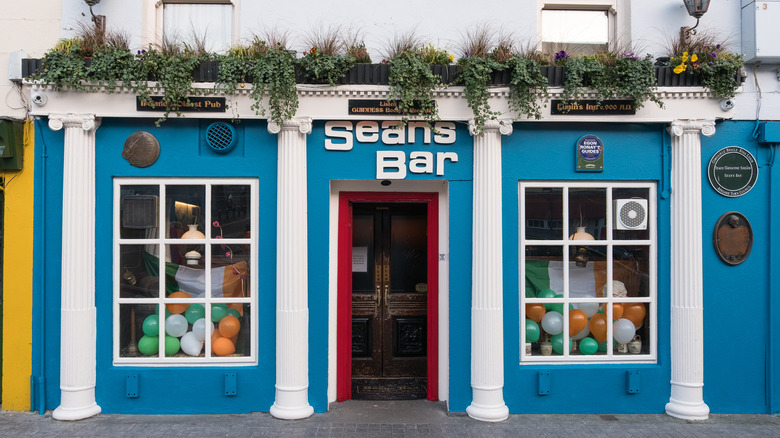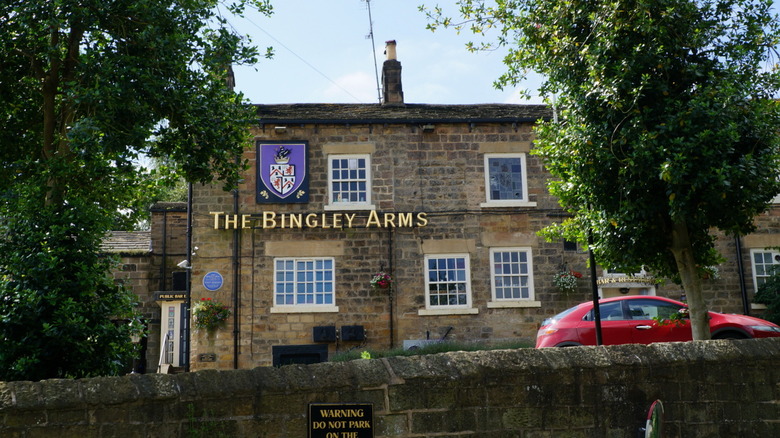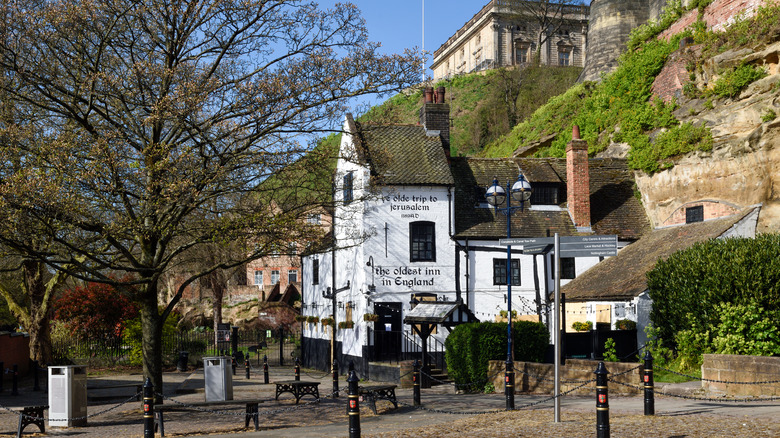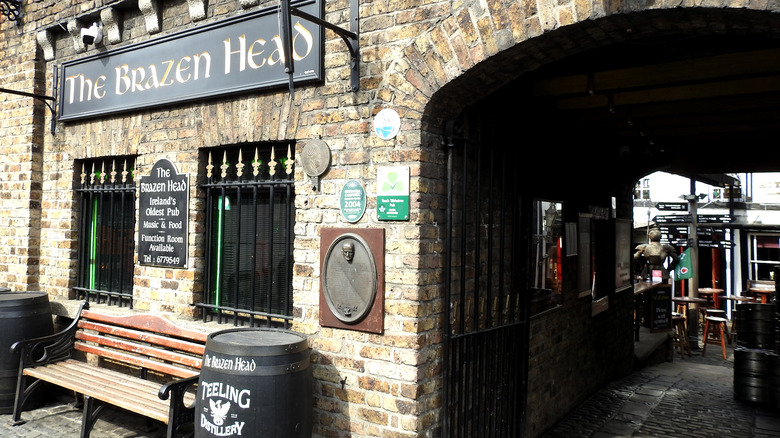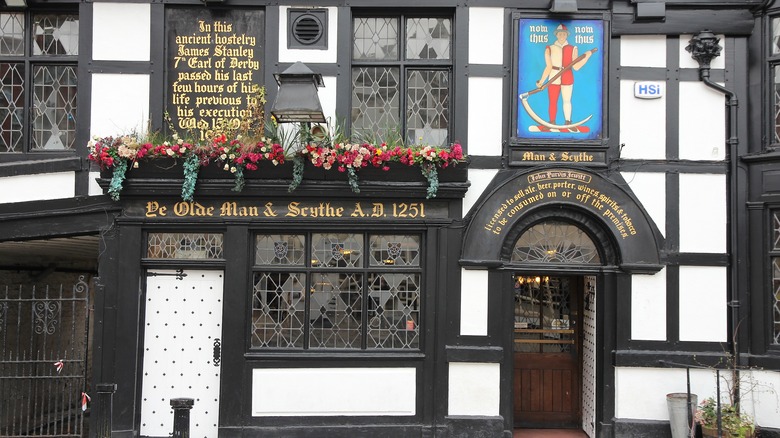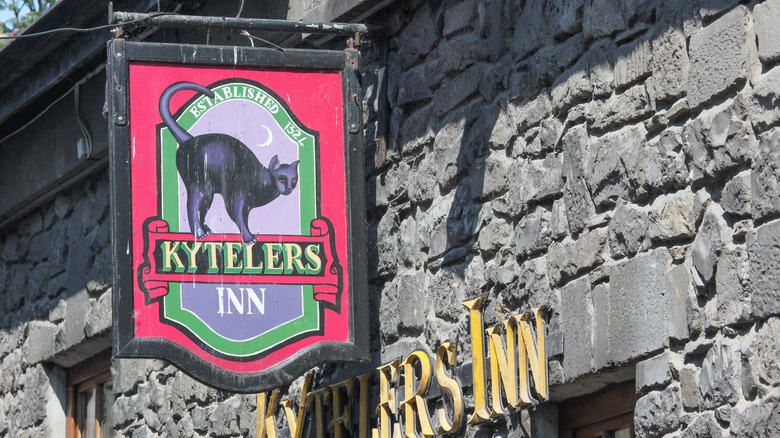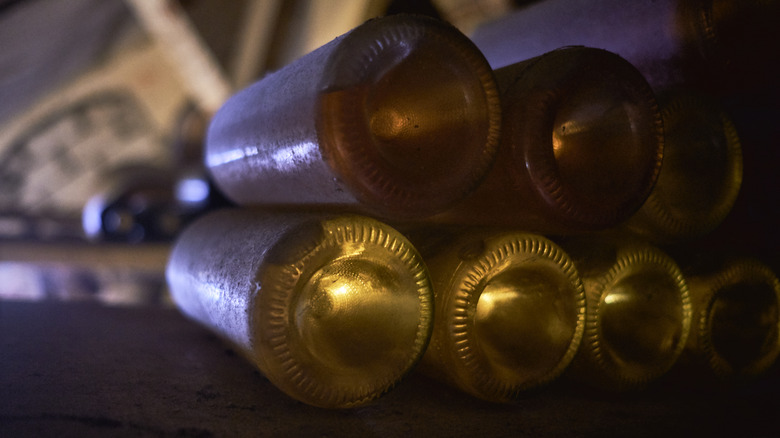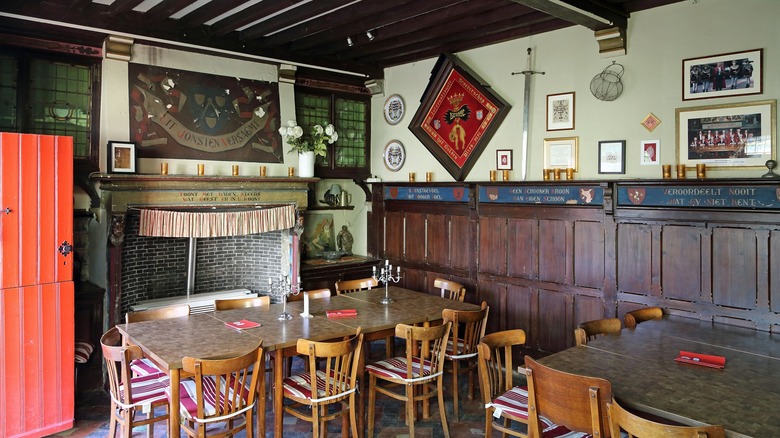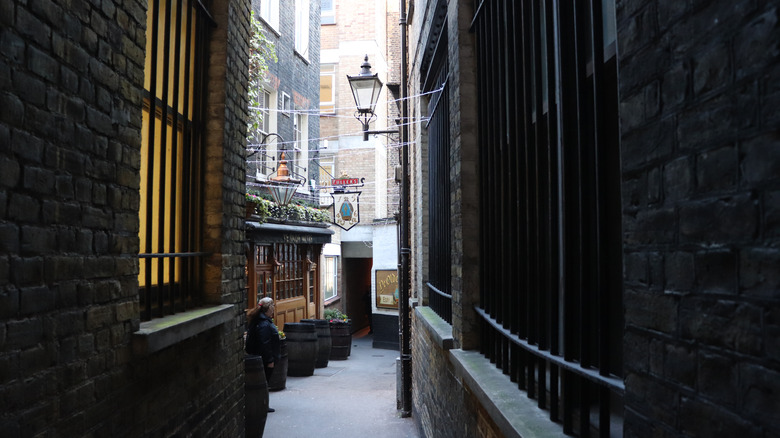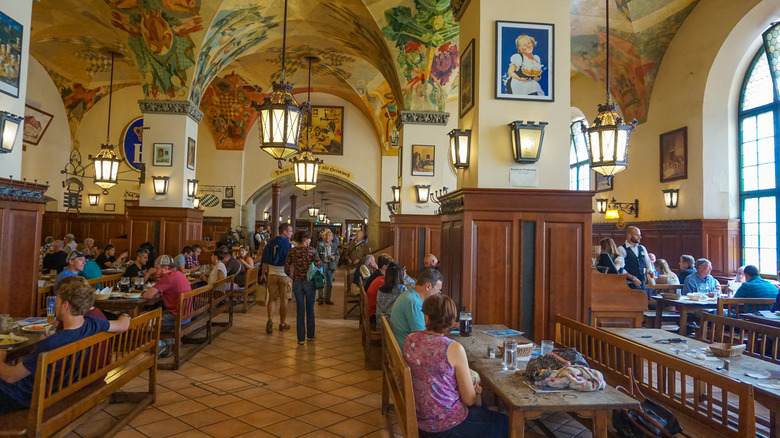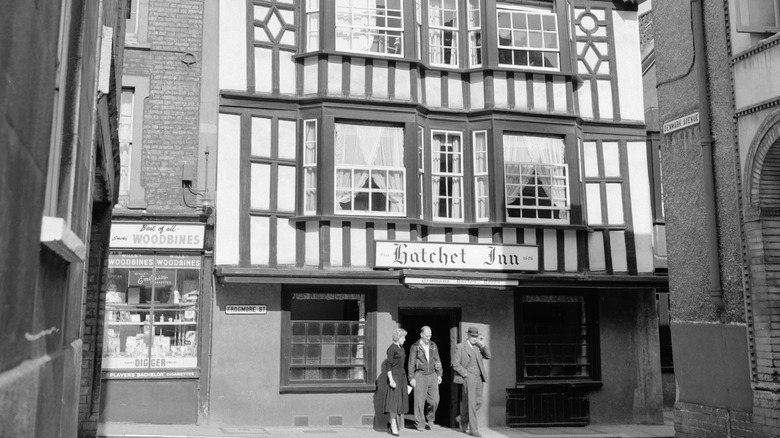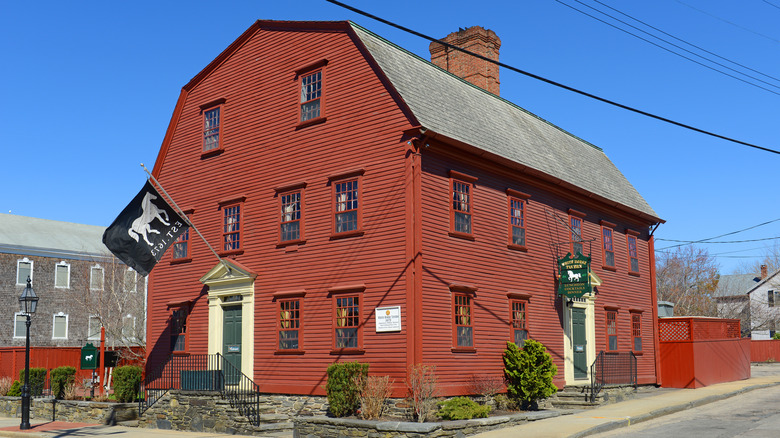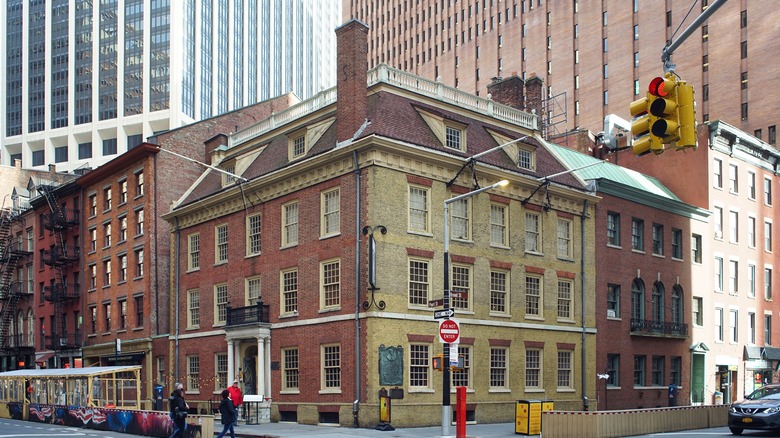The Oldest Bars In The World
One of the riskiest business propositions is opening a bar. Entrepreneur reports that start-up costs can range from tens of thousands of dollars if you buy an existing bar business to millions if you build something completely new. Either way, capital costs alone often drive bars out of business. Still, if a bar owner can make it through the start-up period, they can often turn a hefty profit and last for a long time.
One way bars have been able to promote themselves is by offering a unique value proposition. Some owners specialize in offering wine or martini bars, and some have become noted for live music. One great marketing asset is when you own a bar that's so old that it becomes a curiosity based on age alone. In fact, some bars still pouring pints today were doing so when burning witches at the stake was considered a good idea. Let's take a look at some of these Methuselah-aged bars.
Sean's Bar
The oldest bar in the world is so old that there were only three digits in the year it was founded. Sean's Bar, located in Athlone, Ireland, holds the record for not just the oldest pub in Ireland but probably the world.
BBC reports that Sean's Bar was founded in A.D. 900 under the name Luain's Inn. Real Vikings probably drank there. According to lore, Luain Mac Luighdeach was an innkeeper who helped ferry travelers over a bend in the River Shannon. The town of Athlone was apparently named after Luain since, in Irish, Athlone translates to Atha Luain, meaning the "ford of Luain."
According to Lonely Planet, the exact age of the bar was unknown until the 20th century. This is mainly because back in the day, there were no licensing laws where you would register your business. However, in 1968, the then-owner Sean Fitzsimons began to renovate and found that the walls were made of wattle and wicker, which was a medieval method of building construction. He worked then with the National Museum of Ireland, which dated the walls and other materials using carbon dating. Guinness Records recognized the pub as the oldest in Ireland, and it is assumed to be the oldest in the world. Today, most of the walls and artifacts are found at the National Museum of Ireland, but Sean's Bar does retain one section of the original pub.
Bingley Arms
In Yorkshire, England, in the small village of Bardsey sits Bingley Arms. This pub, according to "Yorkshire's Historic Pubs," dates its history back to A.D. 953, when it was called the "Priests' Inn." The pub took this original name because it offered rest, food, and comfort for monks who were traveling to and from the abbeys of Kirkstall and St. Mary's in York. The Yorkshire Post says that the inn is mentioned in the survey of England ordered by William the Conqueror in the Domesday Book. The pub maintained its ties with the clergy even during the Reformation. Two priest holes were built during the 1500s in order to hide Catholic clergy from persecution. These are still viewable today -– Santa Claus uses the larger one for Christmas parties.
The pub changed its name to the Bingley Arms in 1780 after the Lords Bingley purchased the Bardsey estates. By that time, the monk traffic had subsided. The current owners of the pub pride themselves on its history. Still seen is the original Dutch oven, plus the remains of a secret passage that once connected itself to a nearby church. While its age is great at attracting people far and wide, the maintenance concerns and need for upgrades do endanger the long-term survivability of this ancient bar.
Ye Olde Trip to Jerusalem
If you are a crusader on your way to the Holy Land and happen to pass through the town of Nottingham, you may be tempted to have a cold one at Ye Olde Trip to Jerusalem. This pub, located at the base of and built into the cliffs, claims to have a history dating back to 1189. It was supposedly patronized by crusaders who were off to fight in the Middle East. In fact, Richard the Lionheart was said to have gathered his warriors here. According to AtlasObscura, this bar, despite claims by other establishments, says it's England's oldest pub. It should be noted that according to "Nottingham in Old Photographs," the age is undocumented, so the true age of the pub cannot be corroborated.
Still, the pub is clearly old, and the stony interior gives it a medieval feeling. This was maintained by current operators since, as the Nottingham Post reported, the owners wanted to give visitors a unique experience of time travel. Karl Gibson, the manager of the Trip, stated, "The beauty of it is people love the fact it hasn't been modernized, and you can picture someone sat there hundreds of years ago." Even COVID-19 couldn't keep the Trip down. After lockdowns, the pub ramped up production of its eponymous ale for new generations of bar-goers.
The Brazen Head
The Brazen Head in Dublin, Ireland, claims to be Ireland's oldest, although its purported founding date of 1198. However, there are problems. "Rare Old Dublin" describes how this pub's documentation only goes back to 1613 when it was mentioned in a court claim. Certainly, the bar is older, but pushing it back several centuries is hard to prove. Also, unlike Sean's Bar, which had dateable material, it is unclear how much, if any, of the original building remains. Another mystery is the name although according to "Dublin Pubs" Brazen Head was a common name for pubs after a mechanical head which had been owned by Roger Bacon.
Still, 1613 is not too shabby as far as old bars go. The Brazen Head also has the distinction of being a place where the United Irishmen met (and hid) in the late 18th and early 19th centuries. It was even mentioned by James Joyce in Ulysses when he wrote, "you got a decent enough do in the Brazen Head... for a bob [shilling]."
Ye Olde Man and Scythe
Ye Olde Man and Scythe, in Bolton, England, first appears in the historic record in 1251 when it is noted in a charter. Manchester Evening News reports that the history of this particular bar is a bit grim. During the 17th century, the pub was owned by the family of James Stanley, the seventh Earl of Derby and staunch royalist who, during the English Civil Wars, was partially responsible for the Bolton Massacre, which saw the deaths of about 1,500 people in the pro-Parliament town of Bolton. Stanley was later captured and executed for this in 1651. However, the last few hours of his life were spent in the pub's cellar. According to "Haunted Bolton," it is said that Stanley's ghost haunts Ye Olde Man and Scythe. There is also supposed to be a second ghost, a girl named Jenny who prods visitors, as well as a complaining elderly ghost. While none of this is verifiable, there is an interesting video that shows some sort of paranormalish lights.
Kyteler's Inn
One of the oldest pubs in the world has the additional distinction of being founded by a witch.
Located in Kilkenny, Ireland, this pub's history dates to around 1323. According to AtlasObscura, Dame Alice Kyteler was a powerful Norman aristocrat who increased her power through four different marriages. Like a cunning capitalist, she invested her wealth in new ventures, including a stone inn in Kilkenny. Perhaps it was because she was a wealthy woman in a patriarchal age that caused her to be one of the first people to be accused of witchcraft. She was accused by her stepchildren of having a demon lover and using magic to seduce and then kill her various husbands. The case was brought before the Bishop of Ossory in 1324, but before he could render judgment, Kyteler's supporters took the bishop prisoner. However, when the bishop was released, he was obviously sore about the whole thing and convicted Kilkenny and several of her backers and servants of witchcraft. According to the Brooklyn Museum, because of her connections, she managed to escape to England, though others were burned at the stake.
The Kytelers Inn has gone through ups and downs through the centuries, at points nearly falling into ruin. However, in 1986, it was sold to a new owner who renovated the place and emphasized its medieval roots, rumors of it being haunted, while also modernizing its offerings.
Al Brindisi
The city of Ferrara in northern Italy is known for its wine bars, and Al Brindisi is the oldest. According to "Fodor's Italy," this venue dates at least to 1435. It is likely, 10Best reports, that the bar is far older since it was already well known in 1435. It may have been founded as early as the 1100s when the adjacent city's cathedral was being built. It is speculated it was a place for workers to find rest. As such, 10Best writes that Guinness World Records recognizes the venue as the world's oldest enoteca (wine bar). It is believed that the astronomer Nicolaus Copernicus drank there while a student at the University of Ferrara in 1503. It originally was accessible only by a canal and the street it sits on. The bar has seen a fair share of other luminaries over the ages, including the painter Titian, the sculptor Benvenuto Cellini and more recent visits from Pope John Paul II who visited this famous wine bar to celebrate Copernicus' 500th birthday. Its famous assortment of wine varieties is well-known and shown in its assortment of dusty wine bottles on display throughout the premises.
Café Vlissinghe
Belgian beer is famous, so it is no surprise that there would be some very old beer pubs in that country. Wine Enthusiast reports the oldest to be Café Vlissinghe, located in Brugge within the charming Sint-Anna district. This venue first appears in the written record in 1515 with a Jan Breij as the operator -– the owner is unknown. The building itself is older, though it is unclear when it was built and if it was used as a bar prior to 1515. Still, on its website, it purports to be "probably the oldest pub in the world." Café Vlissinghe has thrived through the ages, being a popular spot in town. Wine Enthusiast also reports that one artistic patron, Peter Paul Rubens, who died in 1640, was cheeky enough to pay his bill by painting a gold coin on the table before sneaking out. This bar has only closed its doors briefly duration during World War II.
Ye Olde Mitre
London is an old city founded by the Romans as Londinium in the 1st century. While there are no surviving Roman bars, it is still unsurprising that there would be many old pubs in this ancient city. One of the most interesting is Ye Olde Mitre, which MyLondon explains was established in 1546. The pub is squirreled away in a surreptitious alley of the Holborn district in central London off Hatton Gardens. The name of the pub probably comes from the fact that it was built for the Bishop of Ely's servants. The pub also has a cherry tree which it is said that Queen Elizabeth I danced around with Sir Christopher Hatton.
The pub itself seems draped in wood and has a cozy atmosphere, including a cheery fireplace. These factors lend themselves an intimacy that is attractive as well as showcasing the building's history. They may also have led it to be named the London Pub of the Year in 2013 by the Society for the Preservation of Beers from the Wood, an organization that promotes the creation of high-quality beer.
Hofbräuhaus
Southern Germany is famous for its beer halls, and there is no place more famous than Munich's Hofbräuhaus. This large tavern was founded first in 1589 by Duke William of Bavaria. "Smoky Goes to Europe" describes how at first, the Hofbräuhaus was directed to produce beer only for the nobility. However, in 1828, King Ludwig I moved it to its current location and opened it to all. According to "One Hundred Years of Brewing," the atmosphere in the Hofbräuhaus became a social equalizer, with upper and lower classes mingling together convivially. The tavern also became famous for its brew. It serves 17,600 pints of Hofbräuhaus beer per day.
The Hofbräuhaus also has some grim skeletons in its closets. The Nazi party was founded there, and History.com tells us that in 1921, a young Adolf Hitler made the moves at the beer hall that brought him in control of the party. The destructiveness of World War II would follow two decades later.
Hatchet Inn
The city of Bristol, England, has a rich maritime tradition of which the Hatchet Inn is an unsavory element. This pub was established in 1606, and according to "Bristol Pubs," it was founded as a rest stop before travelers had to undertake traveling up a large hill. The name itself comes from the fact that woodcutters were often early patrons. Since it was in a secluded, lonely area, it would have been the perfect locale for those who lived on the margins of society to gather. This has given rise to several legends. One, as told by TravelBristol, is that the notorious pirate Edward Teach, better known as Blackbeard, drank at the Hatchet.
Another legend is that the Hatchet was the gathering place for bare-knuckle boxing matches. This is probably untrue, but the legend was born by the fact that many boxers hung out at the Hatchet. One way that patrons of the inn would pass their time, at least in the 18th century, was to bring terriers to the pub. They, and other so-called "sporting men," would go to a pit dug out in the rear of the Hatchet. The dogs would be dropped into the rat-filled pits, and bets made to see how many of the rodents they would kill. These days, the Hatchet has cleaned up its act, catering more to those wielding iPhones rather than cutlasses. According to Bristol Post, it has even undergone a £500,000 renovation while striving to maintain its historic distinctiveness.
White Horse Tavern
The White Horse Tavern of Newport, Rhode Island, looks like a big red barn. But it never was one. According to the Legends of America, the building was constructed in 1652 as a home for Francis Brinley and his family. Then in 1673, William Mayes Sr. saw that its location on the corners of Farewell and Marlborough Streets had possibilities, so he bought it and reconstructed the home into an inn. In 1687 Mayes Sr. obtained the official license and thus the oldest still active bar in the United States was born.
Mayes' son, William Mayes Jr., was also active at the bar. He often served drinks, but he was best known, as reported by AtlasObscura, for being an infamous pirate. Control of the bar was briefly shifted over to his sister, whose descendants then ran the White Horse Tavern for the next two centuries.
The White Horse Tavern was highly central to the early history of Newport. It was used as a political forum, a meeting house, and even as a courthouse. The family sold the building in 1895, and it became converted into a boarding house. It then fell into decay. However, in 1954, the White Horse was bought by the Preservation Society of Newport County and restored. In 1972, it became designated a national landmark. However, it again became privately owned in 1981, from which point it became a popular destination in Newport.
Fraunces Tavern
According to a 2018 report, there are well over 2,000 bars in New York City. Of these, Fraunces Tavern, located in lower Manhattan, is the oldest and historically the most famous. "A Sketch of Fraunces Tavern," tells us that in 1762, Samuel Fraunces, a man of French origin who immigrated from the West Indies, founded the tavern. It became an important site in colonial New York because its size allowed for large meetings. During the years leading up to the American Revolution, the Sons of Liberty met there to plan action against the British. Yet the most well-known scene to occur at Fraunces Tavern happened on December 4, 1783, when George Washington made his famous farewell address to his officers when he returned to private life. The next time Washington returned to New York was to be inaugurated as the first president. Since then, Fraunces Tavern has been bought and sold many times. Today, it incorporates not only a tavern but a museum that examines the American Revolution and New York's involvement in it.
